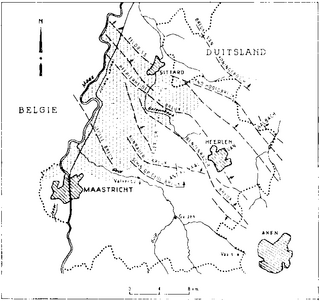
The Maastricht Formation, named after the city of Maastricht in the Netherlands, is a geological formation in the Netherlands and Belgium whose strata date back to the Late Cretaceous, within 500,000 years of the Cretaceous–Paleogene boundary, now dated at 66 million years ago. The formation is part of the Chalk Group and is between 30 and 90 metres thick. It crops out in southern parts of Dutch and Belgian Limburg and adjacent areas in Germany. It can be found in the subsurface of northern Belgium and southeastern Netherlands, especially in the Campine Basin and Roer Valley Graben. Dinosaur remains are among the fossils that have been recovered from the formation.

The Houthem Formation, named after the Dutch town of Houthem, is a geological formation that crops out in the south of Belgian and Dutch Limburg. It has also been found in borings in the northeastern part of the Campine Basin. The formation consists of calcareous sandstone and was formed about 60 million years ago, in the Paleocene epoch.
The Hesbaye Group is a stratigraphic group in the subsurface of northeastern Belgium. This group was deposited during the early Paleocene epoch and is subdivided into two formations: the Houthem Formation (lower) and the Opglabbeek Formation (upper). The group is named after the region of Hesbaye in the south of Limburg.
The Landen Formation is a lithostratigraphic unit in the subsurface of the Netherlands. This formation shares its name with the Belgian Landen Group, but the Belgian unit is thinner and has different definitions. The Landen Formation consists of shallow marine and lagoonal sediments from the late Paleocene to early Eocene. Dutch stratigraphers see the Landen Formation as part of the Lower North Sea Group.
The Hannut Formation is a geologic formation in the subsurface of northern Belgium. The formation consists of marine clay and silt, alternating with more sandy layers. On top of this the lithology changes to limestone, siltstone and sandstone and the top of the formation is formed by a layer of glauconite bearing sand. The Hannut Formation was formed during the early to middle Thanetian age.
The Heers Formation is a geologic formation in the subsurface of Belgium. The formation consists of sand and marl and was deposited in the shallow sea that covered Belgium during the middle to late Selandian age of the Paleocene epoch.
The Tienen Formation is a geologic formation in the subsurface of northern Belgium. The formation crops out in the province of Hainaut and the Hesbaye region in the province of Limburg. It has a late Thanetian (Paleocene) to early Ypresian (Eocene) age.
The Dongen Formation is a geologic formation in the subsurface of the Netherlands. The formation consists of early Eocene marine clay and sand. It is named after the town of Dongen in North Brabant.
The Rupel Formation is a geologic formation in the subsurface of the Netherlands that consists of Oligocene marine sands and clays. The Rupel Formation is part of the Middle North Sea Group and correlates exactly with the Belgian Rupel Group.
The Rupel Group is a stratigraphic group of rock strata in the subsurface of Belgium. It is subdivided into three formations that are all marine deposits of Oligocene age.

The Breda Formation is a geologic formation in the subsurface of the Netherlands. The formation consists of marine glauconiferous sands and clays that were deposited during the Miocene epoch. Although the formation is not very rich in fossils, sometimes bones of fishes, mammals, shells and shark teeth are found.
The Aalter Formation is a geologic formation in the subsurface of northwest Belgium. The formation consists of marine clay and sand, deposited in the shallow sea that covered northern and central Belgium in the Eocene epoch.
The Gentbrugge Formation is a geologic formation in the west of Belgium. The formation crops out in East Flanders and West Flanders and also occurs in the subsurface of the Province of Antwerp. It consists of marine clay, silt and sand, deposited in the shallow sea that covered northern Belgium during the Ypresian age.
The Tielt Formation is a geologic formation in the subsurface of Belgium. The formation crops out in the north of Hainaut, in the southern and central parts of West- and East Flanders and in Walloon and Flemish Brabant. It consists of marine very fine sand and silt, deposited in the shallow sea that covered Belgium during the middle and late Ypresian age.
The Kortrijk Formation is a geologic formation in the Belgian subsurface. This formation crops out in northern Hainaut, southern West and East Flanders and in Walloon Brabant. The formation consists of marine clay from the Ypresian age.
The Veldhoven Formation is a geologic formation in the subsurface of the Netherlands. The formation consists of an alternation of marine clay and sand from the Oligocene epoch.
The Voort Formation or Voort Member is a stratigraphic unit in the subsurface of north Belgium and the south of the Netherlands. The unit has the status of a formation in Belgium but is seen as a member of the Veldhoven Formation in the Netherlands. The Voort Formation consists of shallow marine sands with a late Oligocene age.
The Maldegem Formation is a geologic formation in the Belgian subsurface. The formation consists of alternating marine clay and sand strata, deposited during the late Eocene.
The Brussel Formation is a geologic formation in the subsurface of central Belgium. The formation is named after the Belgian capital, Brussels. It consists of shallow marine sandstone and calcareous sands, deposited in the sea that covered Belgium 45 million years ago, in the Eocene.
The Tongeren Group is a lithostratigraphic unit in the subsurface of Belgium. It consists of shallow marine, epicontinental and/or continental clays and sands from the late Eocene to early Oligocene epochs.


